#Flinders Street Railway Station
Explore tagged Tumblr posts
Text

Flinders Street Railway Station, Melbourne, Australia: Flinders Street railway station is a train station located on the corner of Flinders and Swanston streets in Melbourne, Victoria, Australia. It is the busiest train station in Victoria, serving the entire metropolitan rail network, 15 tram routes travelling to and from the city, as well as some country and regional V/Line services to eastern Victoria. Wikipedia
128 notes
·
View notes
Text

Flinders Street Railway Station, Melbourne, Australia: Flinders Street railway station is a train station located on the corner of Flinders and Swanston streets in Melbourne, Victoria, Australia. It is the busiest train station in Victoria, serving the entire metropolitan rail network, 15 tram routes travelling to and from the city, as well as some country and regional V/Line services to eastern Victoria. Wikipedia
100 notes
·
View notes
Text

#4k#Flinders Street Railway Station#sunset#Melbourne#Australia#Melbourne cityscape#railway station#Melbourne landmarks#Australia cities#wallpapers
0 notes
Text
170 Years of Flinders Street Station (and railways in Victoria)
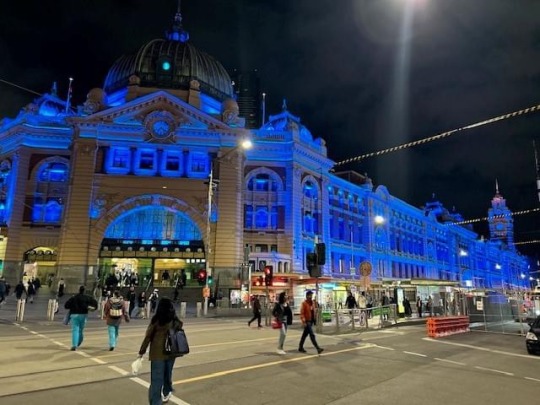
On 12th of September, 1854, Flinders Street Station, the oldest railway station in Australia was opened.
On that same day, the first ever trip on a steam engine was made departing Flinders Street to Sandridge (Port Melbourne) by the Melbourne And Hobsons Bay Railway Company.
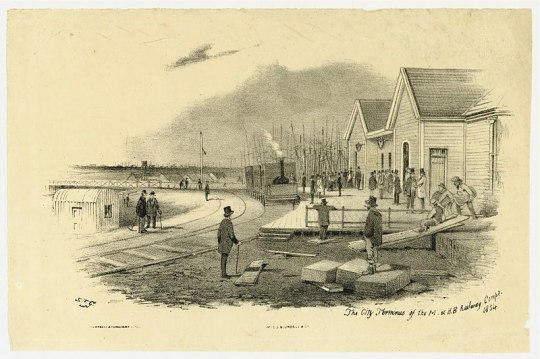
The engine itself was a local built 2-2-2 Well Tank engine that took 10 weeks to build as locomotives ordered from Robert Stephenson and Co of England were not going to arrive in time.
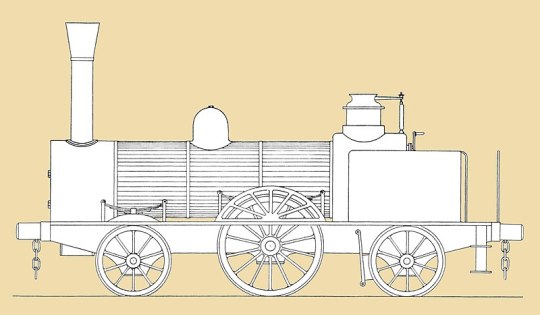
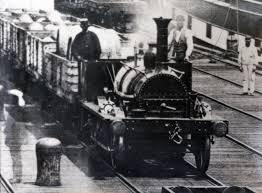
She broke down a lot and services did not resume until Christmas of when the English locos Unfortunately she was not preserved and it is unknown when she was withdrawn and scrapped.
The Victorian Railways were created by an act of Parliament shortly after in 1856 and started operations in 1859; absorbing the Melbourne and Hobson Bay Railway Company and other private companies that had sprung up
Flinders Street Station both preceded and outlived the VR when it was split into the State Transport Authority and the Metro Transport Authority in 1983 and privatised in the 90’s.
Flinders Street Station itself beyond its function as a train station terminus holds a vital place in Melbourne’s culture. You ask anyone in Melbourne to meet ‘under the clocks’ and they will know what you mean.
There was, and still is, a popular ‘70s style black and white photobooth there that was operated for 50 years by a gentleman called Alan Adler, who sadly passed away yesterday, RIP.

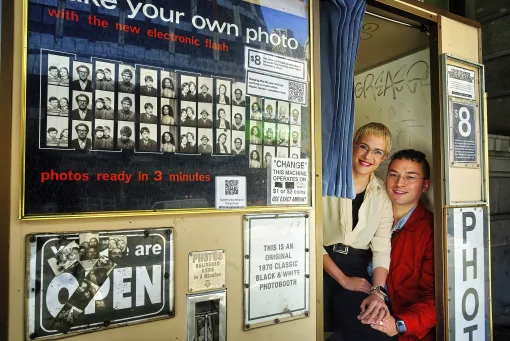
Jess Norman and Chris Sutherland (above) now run the booth.

Flinders Street Station was a popular hangout for youths, but not so much these days.

Two Sharpies at Flinders Street Station sometime in the 1970s.

Did youze all know that Flinders Street Stations has a full sized ballroom?


Yeah.
It was originally a lecture hall for the Victorian Railways Institute, a school the VR had for educating enginemen. But it blossomed into a multiuse space that included a billiards room, a gym and a boxing ring, even a running track on the roof.

The VR in the ‘60s would hold public dances here as well. What’s less known is that few of these dances were Rock ‘n’ Roll dances where Oz’s Rockers/Greasers would gather, and the first generation of Sharpies would gather outside and taunt them and it would turn into a stoush.
*tucks this tidbit away for some VR humanisation AU stories featuring Rocker diesels and Sharpie steam engines*


It’s in a bit of shithouse state at the moment, but hopefully it will be restored in the future.
Here’s to you in your 170th year, Flinders Street Station… several months late but still kind of fitting since we are celebrating 200 years of railways this year.
9 notes
·
View notes
Text

Degraves St looking South towards Flinders St station Melbourne, with the subway excavation in progress.
In 1927, Melbourne City Council began a review of pedestrian access to the station, and traffic flow along Flinders Street.
As the station had become busier, congestion had begun to cause problems. Queues were common during busy periods, causing delays to services. Flinders Street had also become a notorious traffic danger spot, with a high number of accidents occurring near the station.
To alleviate these problems, the council considered several plans, including a pedestrian bridge over Flinders Street.
Finally they settled on an underpass. Degraves Street, a busy thoroughfare in its own right, was directly opposite the Western entrance to the station, the council planned to connect the two with a pedestrian tunnel. Retail shops were included in the design, the revenue from renting these spaces intended to offset some of the cost.
Reaching agreement between everyone involved with the project – State Rail, the State Government, private owners of the land – proved difficult. It was further delayed by the Great Depression, and then World War II, ensured focus was on other issues.
The construction was part of a wider program designed to modernise the look of Melbourne ahead of the 1956 Olympics, championed by the head of the Public Works department, Robert Burns Campbell.
Construction on the subway started in 1952, and was completed early in 1954. Campbell himself only just lived to see its completion, as he died suddenly in June 1954, aged 65.
The new subway was named in his honour: The Campbell Arcade.
Source: https://www.museumoflost.com/the-degraves-street-subway/
Photo 1954.
2 notes
·
View notes
Text
Tram Australian Open, Flinders Street Station, Melbourne: General view of a tram passing Flinders Street Station and hitting the Dunlop Australian Open tennis ball in the Australian city of Melbourne.. The Australian Open is one of the four Grand Slam tournaments. It is the first major tournament of the tennis season that is played every year in January and February in Melbourne, Australia.. Flinders Street railway station is a major railway station located on the corner of Flinders and Swanston streets in Melbourne, Victoria, Australia. Wikipedia
#Dunlop Australian Open tennis ball#Tram Australian Open#Flinders Street Station#Melbourne#Victoria 3000#Australia#oceania#oceania continent
142 notes
·
View notes
Note
i had to look it up but it's cafe andiamo in the collins street precinct. it's right opposite flinders street railway station if i remember correctly.
Ooh nice, thanks
5 notes
·
View notes
Text

Wednesday 1 January 2025 - Main entrance to Flinders Street Station fenced off in the early hours of New Years Day. Plus 21 more new photos in the New Year's Eve trains, CDC Melbourne, Sunshine, TramTracker across Melbourne, Journey Beyond Rail - Great Southern, Metro Tunnel works at CBD South, Melbourne suburban passenger information displays, Metro Trains Melbourne - Caulfield group and Railway advertising and promotions albums https://railgallery.wongm.com/page/archive/2025-01-01/
0 notes
Text
Shock and sadness at assault death of Andrew 'Chewie' Truman
New Post has been published on https://qnews.com.au/shock-and-sadness-at-assault-death-of-andrew-chewie-truman/
Shock and sadness at assault death of Andrew 'Chewie' Truman
Friends and family of Melbourne man Andrew ‘Chewie’ Truman remember the 44-year-old gay man following his death after an attack last week.
“Vibrant, independent and courageous”
These are just some of the words that family and friends have used to describe Andrew Truman following his death.
“He was a marvellous and fierce supporter of the LGBTQIAP+ community and a proud gay man,” his family said via social media.
“He didn’t hesitate to take the lead on the dance floor or in singing karaoke.”
“May we all have at least an ounce of his flavour.”
Truman died in hospital on the weekend following an assault last Wednesday.
His father Geoff Truman said his son had suffered an “unsurvivable brain injury”.
He was hit over the head while walking on Elizabeth Street from Flinders Street in the Melbourne CBD.
Truman sustained significant head injuries in the attack and died tragically from his injuries.
In their statement, Mr Truman’s family thanked anyone who had stopped where he was treated to help.
This included the police, paramedics and medical staff at the Royal Melbourne Hospital.
The police have provided a photo and name of his alleged attacker Todd Menegaldo.
Supplied
Police search for man of interest
On Saturday night, a Victoria Police spokesperson said officers were searching for a man named Todd Menegaldo.
Known by the nickname “Rooster”, Menegaldo has a black and white crossbreed Staffordshire terrier.
Homicide Squad detectives have conducted a significant search since the attack.
They have so far been unable to locate Mr Menegaldo.
He is described as being approximately 180-185cm tall and of thin build.
He was last seen wearing a zip-up purple jumper, dark jeans and a yellow beanie.
He is known to frequent the CBD area around Elizabeth Street and Flinders Street railway station.
He is also known to frequent Mildura and Bendigo.
Police are urging anyone who sees him not to approach him but to contact triple-0.
“unafraid to be himself in any context”
Truman was a passionate Western Bulldogs supporter and played AFL for the Wyndham All Abilities Football and Cricket Club.
A football-loving man who was “unafraid to be himself in any context”.
“His love for football was huge, when not playing he was always at Werribee VFL games or at Western Bulldogs games,” club president Paul Barrett said in a statement.
Known as “Chewie” at the club, he was a five-time premiership player and life member.
“He never let his disability get in the road of what he wanted to do.”
His former club, Williamstown Seagulls FIDA FC, paid tribute online.
“His enthusiasm for football, and especially the Western Bulldogs, was infectious,” the club said.
“He was always ready for a friendly chat.”
Williamstown Seagulls FIDA FC extended their deepest sympathy via social media to Chewie’s family and friends.
“Chewie was an original FIDA player with the Maribyrnong Bulldogs, and then the Wyndham Tigers, where he was a life member.
“His enthusiasm for football, and especially the Western Bulldogs, was infectious, and he was always ready for a friendly chat.”
“Go Long With The Wind.”
Anyone with further information can also contact Crime Stoppers on 1800 333 000 or submit a confidential report online at www.crimestoppersvic.com.au.
For the latest LGBTIQA+ Sister Girl and Brother Boy news, entertainment, community stories in Australia, visit qnews.com.au. Check out our latest magazines or find us on Facebook, Twitter, Instagram and YouTube.
0 notes
Text

WALHALLA DAY OUT
Saturday, 24th August, 2024
Join us on a special tour travelling by road coach to the beautiful Gippsland town of Walhalla.
Walhalla’s picturesque location in the Gippsland mountains combines the wild Australian bush environment with a colonial style reminiscent of the gold era.
Your journey to Walhalla will be in a air conditioned/heated 1987 built Austral Tour Master Road Coach.
Discover a golden past on an informative 45 minute guided tour of an original gold mine.
Ride Walhalla Railway’s narrow gauge train, as it winds its way down Stringers Creek Gorge from Walhalla to the Thomson River.
In your free time you'll have the chance to visit some of the sites in the township including the Iconic old Post Office Museum, Fire Station, lolly shop and Cemetery*.
Morning Tea pack, Lunch at Wally Pub with a delicious pub meal and afternoon tea prior to our return to Melbourne all included.
* Please note: you may not have time to visit all sites within your free time.
WHAT’S INCLUDED
✓ Road Coach to/from Walhalla ^
✓ Morning Tea Pack
✓ Walhalla Goldfield Railway Return 1 hr Ride
✓ Pub Lunch – The Wally Pub
✓ Walhalla Long Tunnel Gold Mine tour **
✓ Free time in Township - choice of visiting#:
* Walhalla Cemetery **
* Historic Fire Station Museum
* Historic Post office Museum
* Town Cafes & Lolly Shop
✓ Afternoon Tea Pack
✓ Views surrounding Walhalla
✓ Welcome Pack
✓ Complementary bottle of water
✓ Yesteryear Travel Guide
** Some sites require walking uphill. Cemetery is uphill and approximately 15 min walk each way to Cemetery.
Price - $169 pp
Includes all as listed above.
Pickup: Ian Potter Centre, Russell St Ext (near Flinders Street/Fed Square) or Dandenong Railway station.
Further information and bookings visit www.yesteryeartravel.com.au
1 note
·
View note
Text

Watercolor of Flinders Street Railway Station in Melbourne.
0 notes
Video
Melbourne, Australia
#Melbourne#Yarra River#Australia#Flinders Street Railway Station#St. Paul's Cathedral#Federation Square#Sony#SonySG#Sony Singapore#Sony A7RII#A7RM2#A7R2#FE1224G#Cityscape#Landscape#Photography#NGC#Victoria#Sunset#Blue Hour#Blue Sky
49 notes
·
View notes
Text

#Flinders Street Railway Station#4k#nightscapes#bridges#road lights#Melbourne#Australia#Melbourne cityscape#Melbourne landmarks#Australia cities#wallpapers
0 notes
Text
Traintober 2024 Day 2: The Game




from the Victorian Railways Newsletter , September 1949
A bit of a history related post today, I am going to natter a bit about railway footy.
The Victorian Railways Institute, a school set up by the VR to educate their employees, had its own amateur Australian Rules competition. This was not uncommon in Victoria where company leagues could spring up in particular avenues of employment (there even a State Bank league for bank employees).
Nor was this uncommon with railways generally, as some of the Big Four railway companies in Britain provided sporting clubs for their employees to participate in.
But the VRI Football League was notable for having players within it that competed in the major leagues as well, the top tier Victorian Football League (the one that is now the Australian Football League today) and the second string Victorian Football Association (which exists only as a rump to the AFL now).
The teams were generally made up of enginemen and staff from various railway lines (Coburg Line, Essendon Line, Heidelberg Line or "Suburban Line"), stations (Flinders Street Station), divisions (Car and Wagon, Goods, railway police), workshops and marshalling yards (North Melbourne Loco, Melbourne Yard, Spotswood). Its to be noted that they did not all compete at at once, seasons running with a few teams on the park according to availability.
They apparently played on Tuesday afternoons and were unpaid, though umpires were paid £2 for the afternoon.
The league competition apparently did keep running until recently but I need to do more research.
Information on hand regarding the VRI-FL is a little difficult to get through so I mainly cribbed this info from "What A Journey" by former VR Station Master Thomas Yates and these fellows here.
#victorian railways#Traintober 2024#Australian Rules football#Victorian Railways history#Traintober 2024 Day 2 : The Game
6 notes
·
View notes
Text


FLINDERS STREET STATION from SWANSTON STREET, on the Northern approach to the single-arch Princes Bridge, looking West past the Southern wall of the old Fish Market, 1874. A photo taken by Charles Bayliss for the Holtermann Collection, State Library of NSW. At that time, Flinders Street Station was a scrappy collection of sheds, brick and corrugated iron construction, with no single building to unify them - that would come in 1910. There was no rail viaduct between Flinders Street and Spencer Street in 1874, so the sole line exiting distantly to the West is the original line, curving left (South) in the distance, leading to Port Melbourne.
0 notes
Photo





Aerial photos of Melbourne (Australia):
Sandridge Bridge across the Yarra River (1925). This bridge carried trains across the river to Port Melbourne.
Princes Bridge over the Yarra River (1927).
Flinders Street railway station (1929).
Russell Street Police Headquarters and the Victorian Trades Hall (1948).
Jolimont Yard (1955).
#history#architecture#transport#railways#police#economics#trade#australian architecture#rivers#australia#victoria#melbourne#yarra river#sandridge bridge#princes bridge#flinders street railway station#russell street police headquarters#victorian trades hall#jolimont yard#australian bridges#trains
26 notes
·
View notes